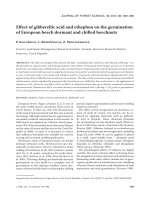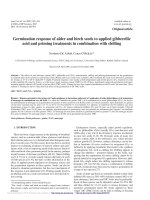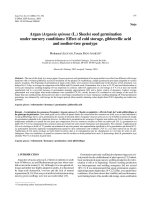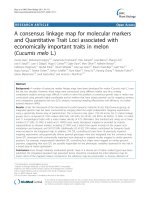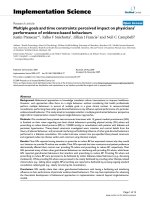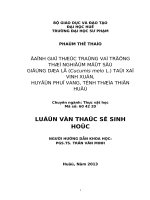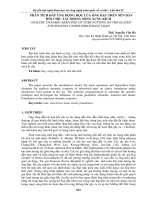Response of Muskmelon (Cucumis melo L.) cv. Durgapur Madhu to different levels of gibberellic acid and time of seed soaking on physico-chemical parameters
Bạn đang xem bản rút gọn của tài liệu. Xem và tải ngay bản đầy đủ của tài liệu tại đây (145.73 KB, 4 trang )
Int.J.Curr.Microbiol.App.Sci (2017) 6(6): 2356-2359
International Journal of Current Microbiology and Applied Sciences
ISSN: 2319-7706 Volume 6 Number 6 (2017) pp. 2356-2359
Journal homepage:
Original Research Article
/>
Response of Muskmelon (Cucumis melo L.) cv. Durgapur Madhu
to Different Levels of Gibberellic Acid and Time of Seed Soaking
on Physico-Chemical Parameters
K.S. Pandya*, L.R. Varma, T. Thomson, J.B. Thakar and S.G. More
Horticulture Instructional Farm, College of Horticulture SD Agricultural University,
Sardarkrushinagar 385506 Gujarat, India
*Corresponding author
ABSTRACT
Keywords
Muskmelon, GA3,
Physico - Chemical
parameters.
Article Info
Accepted:
26 May 2017
Available Online:
10 June 2017
The present investigation entitled, “Response of muskmelon (Cucumis melo L.)
cv. Durgapur Madhu to different levels of gibberellic acid and time of seed
soaking on physico – chemical parameters,” was carried out from February to May
2013 in the summer season at Horticulture Instructional Farm, College of
Horticulture,
Sardarkrushinagar
Dantiwada
Agricultural
University,
Sardarkrushinagar. Experiment was laid out in randomized block design with
factorial concept having four replications. There were five levels of GA3 (0 ppm,
250 ppm. 500 ppm, 750 pm and 1000 ppm) with two soaking periods 16 and 24
hours. There was treatment combinations altogether ten. The results revealed that
maximum number of seeds and maximum non reducing sugar was recorded with
treatment GA3 at 750 ppm, whereas in case of time of seed soaking maximum
diameter of fruit, maximum thickness of pulp, maximum non reducing and total
sugar was recorded with S1 treatments. Over all treatment combination G3S2 (GA3
750 ppm, 24 hours seed soaking) found to be beneficial.
Introduction
Muskmelon is an annual climbing or creeping
herb with large, soft, hairy leaves and
elliptical fruits of varying size and colour. It is
an important vegetable crop cultivated
throughout India particularly in the hot and
dry North Western part of the country.
as high nutritive value. It contains 78.0 %
edible portion, 95.2 g moisture, 0.3 g protein,
0.2 g fat, 0.4 g fiber, 0.11 mg riboflavin, 0.4 g
minerals, 32 mg calcium, 26 mg vitamin C,
3.5 g carbohydrate per 100 g of fresh edible
portion (Chaudhary, 2000).
Muskmelon fetches premium price in the
market compared to other vegetables and is a
popular vegetable grown under both rainfed
and irrigated conditions almost throughout the
year. It has great importance due to its short
duration and high production potential as well
In India area under muskmelon are about 41
(000) hectare with the production of 868
(000) MT (Anon. 2013).
It is widely grown in Bihar, Uttar pradesh,
Punjab, Rajasthan, Gujarat and some parts of
2356
Int.J.Curr.Microbiol.App.Sci (2017) 6(6): 2356-2359
Maharashtra (Chaudhary, 2000). It is grown
on small scale but it has great prospects for
large scale cultivation in the Gujarat state due
to congenial soil and climatic conditions.
Materials and Methods
The investigation was conducted at
Horticulture Instructional Farm, College of
Horticulture, S. D. Agricultural University,
Sardarkrushinagar during the year 2013. The
experiment was laid out in four replications
with Randomized Block Design with
Factorial Concept.
Five levels of gibberellic acid G0 (0 ppm GA3,
soaking of seeds in distilled water), G1 (250
ppm GA3), G2 (500 ppm GA3), G3 (750 ppm
GA3) and G4 (1000 ppm GA3) and two levels
of seed soaking viz. 16 hours (S1) and 24
hours (S2) were taken singly and with
combined form and thus total number of
treatment combinations were altogether ten.
To raise the crop recommended package of
practices was followed. The crop was sown
on 21st February, 2013.
The effect of different treatments was studied
on three randomly selected plants. The mean
values were subjected to statistical analysis
following analysis of variance technique
(Panse and Sukhatme, 1995).
accordance with the findings of Mollier
(2010) in cucumber and Derle (2012) in
muskmelon.
Minimum diameter of seed cavity (cm) was
recorded with treatment G1 whereas in case of
time of seed soaking, minimum diameter of
seed cavity (cm) was recorded with treatment
S1 .
These findings are closely in accordance with
the findings of Derle (2012) in muskmelon.
Maximum thickness of pulp (cm) was
recorded with treatment G4 whereas in case of
time of seed soaking, maximum thickness of
pulp (cm) was recorded with treatment S2.
Similar result was found with treatment of
GA3 (30 ppm) sprayed at 3 to 4 true leaf stage
by Derle (2012) in muskmelon.
Maximum number of seeds per fruits was
recorded with treatment G3 (750 ppm GA3).
Maximum number of seeds was recorded with
treatment G3 whereas in case of time of seed
soaking, maximum number of seeds was
recorded with treatment S2.
Maximum TSS was recorded with treatment
G2 whereas in case of time of seed soaking,
maximum TSS was recorded with treatment
S2 .
Results and Discussion
Maximum diameter of fruit (cm) was
recorded with G4 whereas in case of time of
seed soaking, maximum diameter of fruit
(cm) was recorded with treatment S2.
This might be due to possible reason may be
cell elongation and cell multiplication in
fruits. These findings are closely in
Similar result was found by Ram et al., (2001
and 2003) in muskmelon and Hidayatullah et
al., (2011) in cucumber. Maximum TSS
should be increased due to diversion of more
solids toward developing fruits and might also
have enhanced the conversion of complex
poly saccharides in to simple sugar (Deepthi
et al., 2008).
2357
Int.J.Curr.Microbiol.App.Sci (2017) 6(6): 2356-2359
Table.1 Response of musk melon (Cucumis melo L.) cv. Durgapur Madhu to
different levels of gibberellic acid and time of seed soaking on yield parameters
GA3
G
G0
G1
G2
G3
G4
S.Em±
CD @ 5 %
S
S1
S2
S.Em±
CD @ 5 %
GXS
S.Em±
CD @ 5 %
CV%
Diameter of
fruit (cm)
Diameter of seed
cavity (cm)
Thickness of
pulp (cm)
No. seeds / fruit
8.31
8.20
9.51
9.33
10.51
0.11
0.32
5.01
4.77
5.43
5.08
5.98
0.07
0.20
2.25
2.07
2.32
2.37
2.45
0.04
0.13
310.50
141.12
263.12
416.75
323.12
9.77
28.35
8.73
9.61
0.07
0.20
4.97
5.55
0.04
0.13
2.23
2.36
0.03
0.08
284.70
297.15
6.18
NS
0.16
0.45
3.40
0.10
0.28
3.73
0.06
0.18
5.40
13.82
40.10
9.50
Table.2 Response of musk melon (Cucumis melo L.) cv. Durgapur Madhu to
different levels of gibberellic acid and time of seed soaking on yield and benefit cost ratio
GA3
G
G0
G1
G2
G3
G4
S.Em±
CD @ 5 %
S
S1
S2
S.Em±
CD @ 5 %
GXS
S.Em±
CD @ 5 %
CV%
TSS
( brix)
Reducing sugars
(%)
Non reducing
sugars (%)
Total Sugars
(%)
9.36
10.17
11.60
10.00
10.52
0.085
0.25
3.68
3.57
3.50
3.62
3.75
0.05
0.14
5.17
5.40
5.66
5.71
5.68
0.06
0.18
8.86
8.98
9.16
9.34
9.43
0.08
0.23
10.28
10.38
0.05
NS
3.58
3.67
0.03
NS
5.45
5.60
0.04
0.19
9.03
9.27
0.05
0.15
0.12
0.35
2.33
0.07
0.20
3.86
0.08
0.24
3.02
0.11
0.32
2.45
o
2358
Int.J.Curr.Microbiol.App.Sci (2017) 6(6): 2356-2359
Maximum reducing sugar was recorded with
treatment G4 whereas in case of time of seed
soaking, Maximum reducing sugar was
recorded with treatment S2.
Maximum non reducing sugar was recorded
with treatment G3 whereas in case of time of
seed soaking, maximum reducing sugar was
recorded with treatment S2.
Maximum total sugar was recorded with
treatment G4 whereas in case of time of seed
soaking, Maximum reducing sugar was
recorded with treatment S2 (Tables 1 and 2).
Similar results were observed by Deepthi
(2008) in muskmelon and Mollier (2010) in
cucumber.
From the investigation it can be concluded
that different levels of GA3 and time of seed
soaking was significantly influenced physicochemical parameters of muskmelon. The
treatment G3 (750 ppm GA3) and treatment
combination G3S2 (750 ppm GA3, 24 hours
seed soaking) found to be beneficial.
References
Anonymous (2013). NHB Database- 2013.
Ministry of Agriculture, Government of
India
Chaudhary, B. (2000). Vegetable production,
National Book trust pub. New Delhi,
150-151 Pp.
Deepthi, H.R. (2008).Physiology and quality
of muskmelon (Cucumis melo L.) as
influenced by plant growth regulators.
M.Sc thesis submitted to the University
of Agricultural sciences, Dharwad.
Derle, R. K. (2012). Effect of gibberellic acid
and maleic hydrazide on growth, se
expression, yield and quality of
muskmelon cv. Durgapur Madhu. M.Sc
thesis submitted to Sardarkrushinagar
Dantiwada Agriculture University,
Sardarkrushinagar
Hidayatullah, Bano, A., Khokhar, K. M. and
Mahmood, T. (2011). Effect of seed
soaking
treatment
with
growth
regulators on phytohormone level and
sex modification in cucumber (Cucumis
sativus L.). Afri. J. Pl. Sci.5 (10): 599608.
Mollier. (2010). Influence of plant growth
regulators on growth, physiology and
yield in cucumber. M.sc thesis
submitted to the University of
Agricultural sciences, Dharwad.
Panse, V. G. and Sukhatme, P. V.
(1995).Statistical
methods
for
agricultural workers, ICAR. Pub., New
Delhi.
How to cite this article:
Pandya, K.S., L.R. Varma, T. Thomson, J.B. Thakar and More, S.G. 2017. Response of
Muskmelon (Cucumis melo L.) cv. Durgapur Madhu to Different Levels of Gibberellic Acid
and Time of Seed Soaking on Physico-Chemical Parameters. Int.J.Curr.Microbiol.App.Sci.
6(6): 2356-2359. doi: />
2359
